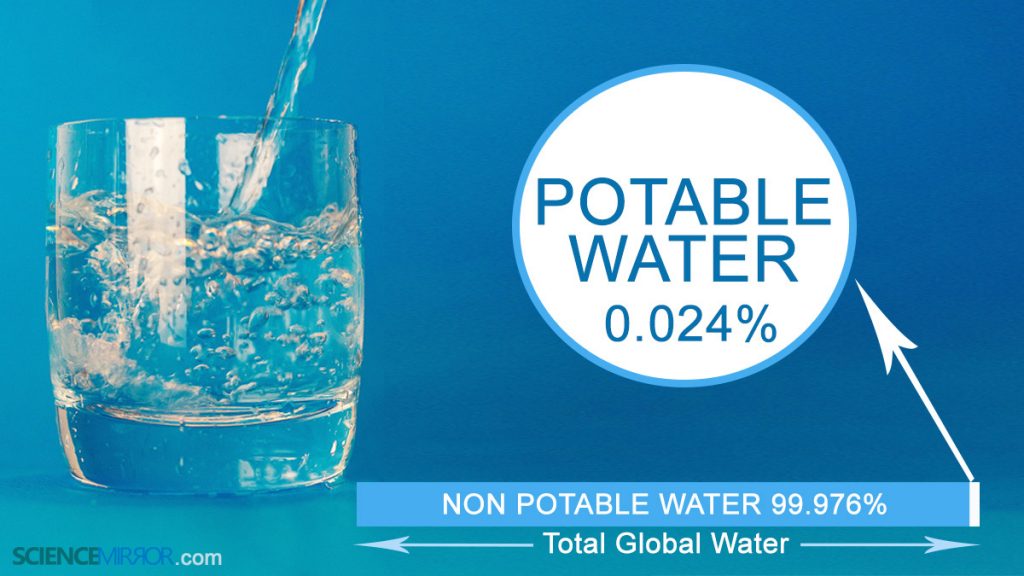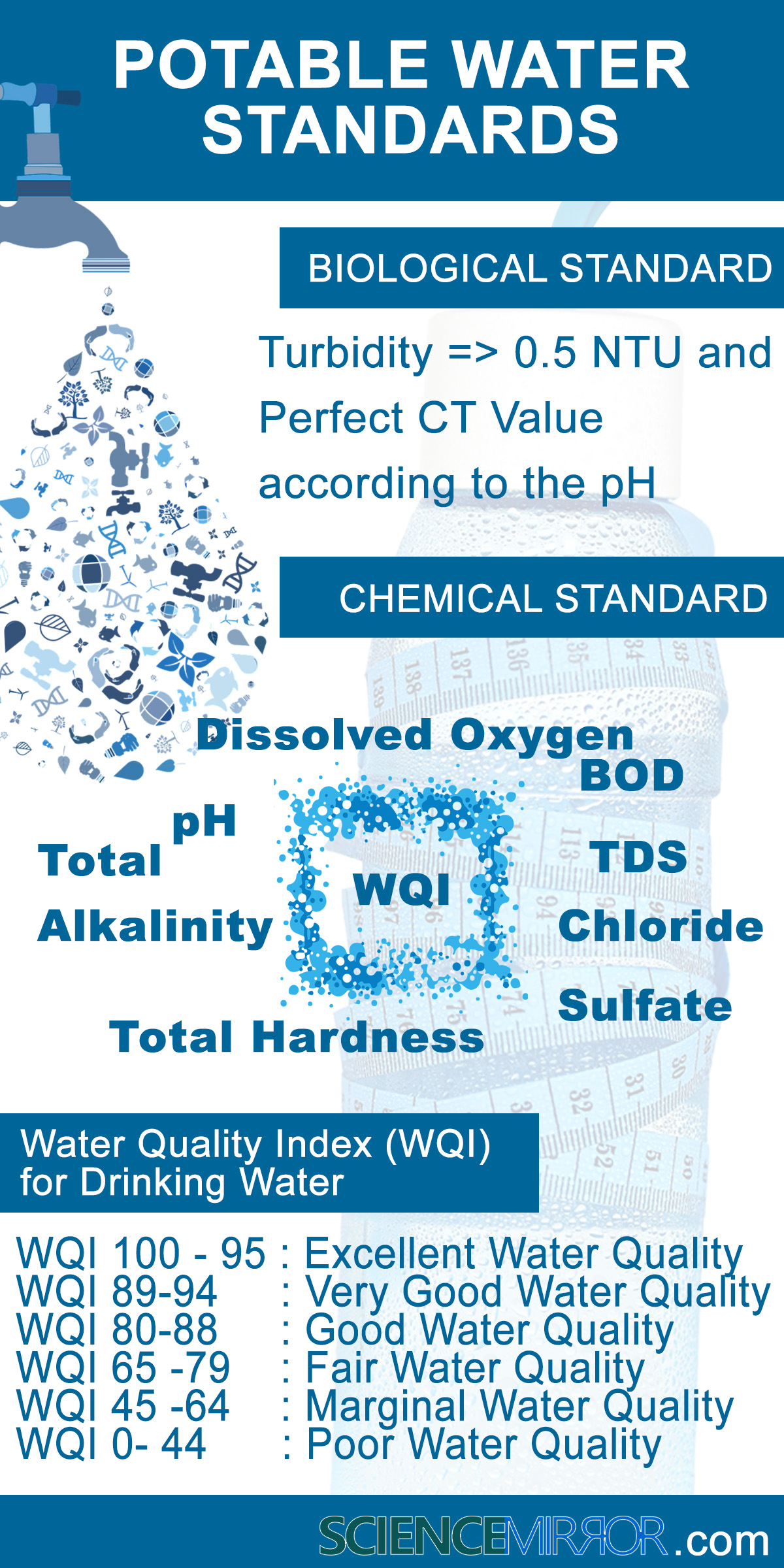Potable water defines as drinking water that can consume for a lifetime without any health risk. It is a significant part of our diet, and water quality sensitivity varies for our different life stages.
What do you think about your last cup of water? Was it safe? You can decide about it after going through this article.
Concerning water quality is very important. Because we usually intake 2.7 litres of water per day. Depending on water quality, we face deathly chronic and acute illnesses.
Look,
Each year diarrhoea kills 2.2 million people an acute result of lousy water consumption. Then, you may probably know about CKDu (Chronic Kidney Disease of Unknown aetiology). It causes thousands of deaths in some regions. Scientists believe it is a result of long term unhealthy water consumption.
Yes, It is a fundamental human right to access portable drinking water. Let’s see whether you have this access or not.
Potable water supply and sources.
As you see, Most of our planet surface covers by the ocean. This results in 96.5 % of total global water occur as saltwater. Therefore, only 2.5 % of global water is found as freshwater.
Can we use this 2.5 %? Unfortunately, no.
Out of this freshwater, the majority (68.7%) is freezing as glaciers and ice caps. These white glaciers are essential to managing the planet’s energy budget.
In summary, only about 0.024% of the total global water sources ready for our consumption.

These facts show us there is a smaller amount of water is available for our drinking purpose. But water pollution limits this access furthermore.
With this challenge, we have to find sustainable water sources and secure our water security.
As an individual, you can find safe drinking water in various ways. It depends on where you live and social, economic, and cultural background.
Common potable water supply ways are,
- Public water supply systems via pipes. (Tap water)
- Bottled water
- Tube wells and dug wells.
Public Water Supply Systems.
These systems manage by government or local authorities. If your living region rich with surface water sources such as rivers, lakes, and reservoirs. You can find a public water pipeline system.
It is essential to purify surface water before usage. Highly populated areas eventually have polluted surface water. Agriculture and factories are the main reason for this pollution. We will discuss this later in this article.
In this type of supply systems, there is a charge to cover the purification cost according to your consumption rate.
Properly implemented water purification plants can deliver 99% of safe water for drinking without any further processes. Therefore, you have to look at the quality control of your local public water supply system to ensure your safety.
Some supply systems use groundwater as their water source. Most of those types of supply systems do not go for the high-end purification process.
In rural areas, you can find rainwater harvesting systems as the water sources. Areas with minimum surface and groundwater sources cover their water requirements with this method. But there is a limited water supply rate.
In summary, If you are using tap water, You should be aware of the water source, quality control methods, and supply rates of the system. Those factors will help to ensure your household water security.
Bottled Water
When we are travelling, we usually use bottled water. The main reason is that we don’t have an idea about the water safety of each area.
People living in regions that lack a safe public water system, practice water bottles for their daily water usage
There are regulations to bottled water manufacturing specify by local governments. As an example, united states have bottled water regulation implemented by the FDA.
Companies use different water sources for their manufacturing process. You can find the water source from the bottle label. Most standard water sources are,
1. Springs
There are natural water flows from underground water paths. For form a spring, the area should be rich with water. Companies use this overflowing water for bottling.
2. Artesian wells.
These Artesian wells are a groundwater source. Water collected in the underground in porous spaces. The upper limit of that water body known as an aquifer. When this aquifer taps with hard rock, It makes an environment to develop high water pressure in a water body called as artesian pressure. Companies drill the hard rock to the water body and obtain water easily via the artesian pressure gradient.
3. Well water
The difference with artesian well and this water source is using a mechanical method to extract groundwater. Companies drill ground until finding the aquifers and use electric motors to extract water.
Mostly you can find bottled water products with well water.
4. Mineral Water
If you find a water bottle labelled as “mineral water,” that bottle contains water precisely as occurred in groundwater. That means that water has been bottled without any purification process that changes the mineral content of the water
Typically, to be mineral water, the water source must have a total dissolved solid at least 250 ppm. Due to balanced mineral content, mineral water is more pleasant than other bottled water types. This makes a high demand for mineral water bottles as potable water.
After extraction or water collection, manufactures go through a disinfection process before bottling. This disinfection process helps to keep water as blotted for a long time.
Tube wells and Dug wells
Tube wells and dug wells are common in rural areas. These wells may be public or private. If your land situated over a groundwater body and aquifer is not far depth, you can have a one for your water security.
Tube wells are more secure and safe than the dug wells. Because tube well do not directly open aquifer to the surface as the dug wells. This makes less contamination.
Before you go to dig a well, you should consider about the water quality of the groundwater body in your area. You can check it by neighbours’ wells or using groundwater quality maps.
As an example, some areas have high fluoride content in groundwater. Intake of high fluoride cause fluorosis. To avoid these types of health risks, you should have a water quality test for your own home well.
Now we have an idea about safe water sources. How these sources become unhealthy? What are the primary contaminants responsible for that? Let’s look at it.
Drinking water Contamination
There are four main types of contaminates. Biological, Organic, Inorganic, and radiological. Biological contaminants cause acute illnesses, while others responsible for chronic diseases with low concentrations.
1.Biological
1993 Cryptosporidiosis outbreak in Milwaukee, United States, shows us the importance of pathogens free source. That outbreak was happened due to microscopic parasites, cryptosporidium.
Vibrio cholera, Shigella, Salmonella Typhi cause deadly diseases Cholera, Dysentery, and Typhoid, respectively. These are the example of common water-borne bacterial infections.
There are working antibiotics to cure bacterial diseases, but virus diseases are hard to cure. Adenoviridae, Astroviridae, Caliciviridae, like virus families, cause gastroenteritis.
Some Protozoa, like Acanthamoeba, Cryptosporidium, and Cyclospora, are responsible for water-borne diseases. Also, Ascaris, Taenia, like Helminths (worms), have the opportunity to transmit through water.
2. Organic
Organics are the common contaminates. The reasons are most chemical companies manufacture polymer-based products, and our lifestyle already linked with these products. The following list shows some organics that cause problems.
- Volatile organic compounds – e.g., Petrochemical Products.
- Synthetic industrial chemicals – e.g., Resins, Dyes.
- Antiseptics – e.g., triclocarban
- Pharmaceuticals – e.g., antibiotics
- Personal care products – e.g., Cosmetics
3. Inorganic
Do you know about the hardness of water? We can get an idea about Magnesium and calcium amount in water through hardness value. Mostly hardness depends on natural inorganic factors. Such as geological environment.
Fluoride, nitrate, nitrite, ammonia, and heavy metals such as chromium, lead, mercury, nickel, cadmium, copper, arsenic cause health risks when in high concentrations.
Popular Minamata disease in Japan was due to mercury poisoning. An arsenic poison case was in Bangladesh after implementing unsafe tube wells. These incidents remind us to consider about inorganic contaminants of our aqua sources.
4. Radiological
If you are around a nuclear power plant, it is better to consider radiological contaminants. Radionuclides, elements that release alpha, beta, and gamma rays, may reach in water for a period.
Uranium, Plutonium, caesium are some examples of radiological contaminants. These cause cancers when exposed to a high amount of radiation.
We need to free from these contaminants for having a safe glass of water. So, Knowledge of treatment technologies rea important.
How to make potable water
Water treatment methodologies are various according to the requirements. However, large purification plants have two essential steps to remove the contaminants mentioned above.
Primary Treatment
Primary treatment is a physical treatment process. Remove large debris and suspended solids. In a standard water treatment plant, you can observe several steps. They are Primary screening, aeration, coagulation, flocculation, and sedimentation.
At the end of the primary treatment, the water is free from organic nitrogen, phosphorus, and heavy metals.
Secondary Treatment.
Aeration in primary treatment removes anaerobic bacterial pathogens. But it needs further steps to remove other biological contaminants. Secondary treatment techniques do that duty.
Commonly used disinfection methods are,
- Membrane filtration
- Chlorination
- UV Radiation
- Reverse osmosis
All about treatment techniques applies for large scale treatment plants. Then, How do we prepare our household treatment process?
How to clean drinking water at home?
Are there any streams, rivers or a well near your home? Let’s see how to increase the portability of those resources.
As the large scale treatment plant, for remove debris and micro-sized particles, initially, we can filter raw water through the clean white colour cloth.
Observe the colour of the water sample. It should be clear. And check the order. The water sample should be free from any unpleasant order. If the water sample has an unpleasant order and colour, you should filter water at least through a gravel filter.
Boiling resolves most of the issues. It helps to kills pathogens like bacteria. Removes volatile organic compounds and also reduce the hardness. Therefore, it is better to boil unsafe water before consumption.
You can find several commercial filters for home-usage.
Potable Water filters for home.
- Activated carbon filter – Able to remove volatile organic compounds (VOC) and inorganics like lead.
- Sediment Filter – Removes large particles like sand and dust.
- Reverse osmosis – This is most common in rural areas, able to remove VOC pesticides and most minerals.
- Ultraviolet – Kills all type of microorganisms
- Ultrafiltration – Remove microbes while keeping essential minerals for health
- Activated alumina filters – Capable to remove arsenic and fluoride
- Ion exchange filters – Able to remove both positive and negative charged ions
- Distillation – Removes all types of minerals
- Water ionizer – Helps to manage the pH of the water.
You should carefully select a filter for your home. For that, you should consider the water quality of your source, required output, and management cost of the filter systems.
Distillation like methods removes all essential ions. Reduction of essential ions is a considerable problem for your nutrition. Therefore, it is better to go for typical filters like activated carbon filters for less polluted sources.
Water is considered as a food. Then It should have a standard.
Potable water standards.
There is no universal standard. It is unique to regions and community requirements. There is specific water standard for European community. Your local standard depends on environmental, social, cultural, economic and dietary condition factors.
However, we can have a general standard according to biological and chemical water quality parameters.
Biological Quality
As we discussed above, your water source should be free from pathogens. Microbiological tests should perform to ensure biological quality. But tests like coliform is time-consuming.
But you can get an idea with physical and chemical parameters. A pathogen-free sample should have turbidity equal to or less than 0.5 NTU.
Disinfectants ensure biological quality and Effectiveness of chemical disinfection measures with CT Value. This value is the product of disinfectant concentration and time of contact. Depending on the pH plant enginers adjust CT Value using the CT table.
Chemical quality.
There are too many parameters to measure chemical quality. But for potable water, we use the Water Quality Index (WQI). This index calculates using BOD, Dissolved Oxygen (DO) pH, TDS, total hardness, total alkalinity, chloride and sulfate.
There is a weighted arithmetic index for calculating WQI. WQI value ranges from 0 to 100. Higher the value means excellent for a drink.
In addition to WQI, your region may follow standards for other parameters. As an example, local areas with high fluoride content in water imply limitation for fluoride concentration.

After incrementing of potability, It is essential to store properly until the usage. For house hold usage, there are serval types of water tanks with different materials. Most commonly used tanks are polypropylene or polyethene plastics. But law quality plastics have health risks when exposed to hard conditions like high sunlight. Therefore if it is possible, you can choose concrete or steel tanks.
Potable water is one of the basic requirement for our survival. That is why you can see people give priority to find water even in mars exploration. Therefore give attention to water in your mug. And think about the safety and security according to our above discussion.


